Mechanical Behavior Investigation of Reclaimed Asphalt Aggregate Concrete in a Cold Region
Abstract
:1. Introduction
2. Experimental Programs
2.1. Reclaimed Asphalt Mixture Sieve Analysis and Mix Design
2.2. Axial Compressive-Strength Test
2.3. Splitting Tensile Strength Test
2.4. Dry- and Temperature-Shrinkage Tests
2.5. Freeze-Thaw Cycle and Water-Stability Test
3. Experimental Test Results
3.1. Sieve Analysis
3.2. Axial Compressive-Strength Tests
3.3. Splitting Tensile-Strength Tests
3.4. Dry- and Temperature-Shrinkage Tests
3.5. Freeze-Thaw Cycle and Water-Stability Tests
3.6. Microcosmic Analysis
4. Numerical Simulation Analysis
(20% ≤ X ≤ 60%, 3% ≤ Y ≤ 6%)
(20 ≤ X ≤ 100, 0% < Y ≤ 6%)
5. Conclusions
Author Contributions
Funding
Institutional Review Board Statement
Informed Consent Statement
Data Availability Statement
Conflicts of Interest
References
- Md, T.R.; Abbas, M.; Filippo, G. Recycling of Waste Materials for Asphalt Concrete and Bitumen: A Review. Materials 2020, 13, 1495. [Google Scholar]
- Yail, J.K.; Ji, Y.C.; Troy, B. Uncertainty Modeling of Carbon Fiber-Reinforced Polymer Confined Concrete in Acid-Induced Damage. ACI Struct. J. 2019, 116, 97–108. [Google Scholar]
- Ma, T.; Zhao, Y.L.; Huang, X.M. Key Technology of Heat Mixing Regeneration in Asphalt Pavement Plant; Southeast University Press: Nanjing, China, 2015. [Google Scholar]
- Yueqin, H.; Xiaoping, J.; Jia, L.; Xianghang, L. Adhesion between Asphalt and Recycled Concrete Aggregate and Its Impact on the Properties of Asphalt Mixture. Materials 2018, 11, 2528. [Google Scholar]
- Gilda, F.; Andrea, G.; Chiara, M.; Andrea, G. Comparing the Field and Laboratory Curing Behaviour of Cold Recycled Asphalt Mixtures for Binder Courses. Materials 2020, 13, 4697. [Google Scholar]
- Aleksandar, R.; Ivan, I.; Michael, P.W.; Dimitrije, Z.; Marko, O.; Goran, M. The Impact of Recycled Concrete Aggregate on the Stiffness, Fatigue, and Low-Temperature Performance of Asphalt Mixtures for Road Construction. Sustainability 2020, 12, 3949. [Google Scholar]
- Hasan, K.; Erol, T.; Sheila, B. Using Accelerated Pavement Testing to Evaluate Reclaimed Asphalt Pavement Materials for Pavement Unbound Granular Layers. J. Mater. Civ. Eng. 2017, 29, 04016205. [Google Scholar]
- Goshtasp, C.; Augusto, C.F.; Zhanping, Y.; Siyu, C.; Yun, S.K.; Jan, W.; Ki, H.M.; Michael, P.W. Warm mix asphalt technology: An up to date review. J. Clean. Prod. 2020, 268, 122128. [Google Scholar]
- Olivera, Ð.; Aleksandar, R.; Dimitrije, Z.; Božidar, Ð. Potential of Natural and Recycled Concrete Aggregate Mixtures for Use in Pavement Structures. Minerals 2020, 10, 744. [Google Scholar]
- Qibo, H.; Zhendong, Q.; Jing, H.; Dong, Z.; Leilei, C.; Meng, Z.; Jinzhu, Y. Investigation on the properties of aggregate-mastic interfacial transition zones (ITZs) in asphalt mixture containing recycled concrete aggregate. Constr. Build. Mater. 2021, 269, 121257. [Google Scholar]
- Arabani, M.; Moghadas, N.F.; Azarhoosh, A.R. Laboratory evaluation of recycled waste concrete into asphalt mixtures. Int. J. Pavement Eng. 2013, 14, 531–539. [Google Scholar] [CrossRef]
- Merzouki, T.; Bouasker, M.; Khalifa, N.E.H. Contribution to the modeling of hydration and chemical shrinkage of slag-blended cement at early age. Constr. Build. Mater. 2013, 44, 368–380. [Google Scholar] [CrossRef]
- Areej, A.; Nasim, S.; Ahmed, A.; Hasan, K. Influence of temperature on mechanical properties of recycled asphalt pavement aggregate and recycled coarse aggregate concrete. Constr. Build. Mater. 2021, 269, 121285. [Google Scholar]
- Yasser, K. Self-compacting concrete using recycled asphalt pavement and recycled concrete aggregate. J. Build. Eng. 2017, 12, 282–287. [Google Scholar]
- Le, D.; Junhui, Z.; Bowen, F.; Cheng, L. Performance Evaluation of Recycled Asphalt Mixtures Containing Construction and Demolition Waste Applicated as Pavement Base. Adv. Civ. Eng. 2020, 7, 8875402. [Google Scholar]
- Jayakody, S.; Zimar, A.M.Z.; Ranaweera, R.A.L.M. Potential use of recycled construction and demolition waste aggregates for non-structural concrete applications. J. Natl. Sci. Found. Sri Lanka. 2018, 2, 205–216. [Google Scholar] [CrossRef]
- Cardoso, R.; Silva, R.V.; Brito, J.D. Use of recycled aggregates from construction and demolition waste in geotechnical applications: A literature review. Waste Manag. 2016, 49, 131–145. [Google Scholar] [CrossRef] [PubMed]
- Arulrajah, A.; Disfani, M.M.; Horpibulsuk, S. Physical properties and shear strength responses of recycled construction and demolition materials in unbound pavement base/subbase applications. Constr. Build. Mater. 2014, 58, 245–257. [Google Scholar] [CrossRef]
- Komnitsas, K.; Zaharaki, D.; Vlachou, A. Effect of synthesis parameters on the quality of construction and demolition wastes (CDW) geopolymers. Adv. Powder Technol. 2015, 26, 368–376. [Google Scholar] [CrossRef] [Green Version]
- Yang, Y.; Wang, L.; Feng, Y. Study on fractal mathematical models of pulverizing theory for ore. Powder Technol. 2016, 288, 354–359. [Google Scholar] [CrossRef]
- Chen, R.; Fang, M.X.; Li, M. Size distribution and particle shape of iron ore powder based on the fractal theory. Mater. Res. Innov. 2015, 19, 405–409. [Google Scholar] [CrossRef]
- Jing, H.Z.; Yun, C.S.; Shu, J.B. Experimental Study on the Loaded Property of Waste Fiber Recycled Concrete Beam-Column Joints. Appl. Mech. Mater. 2015, 727, 69–72. [Google Scholar]
- Saeed, F.; Reza, I. Performance evaluation of recycled asphalt mixtures by construction and demolition waste materials. Constr. Build. Mater. 2016, 120, 450–456. [Google Scholar]
- Akash, B.; Amy, E.M.; Gayle, K.; Charles, G.; Fawaz, K.; Edith, A.M. Evaluation and classification of recycling agents for asphalt binders. Constr. Build. Mater. 2020, 260, 119864. [Google Scholar]
- Wojciech, B. Evaluation of Fatigue Life of Asphalt Concrete Mixtures with Reclaimed Asphalt Pavement. Appl. Sci. 2018, 8, 469. [Google Scholar]
- Juntao, L.; Lin, H.; Yue, X.; Fang, X.; Pan, P. Long-term performance characteristics and interface microstructure of field cold recycled asphalt mixtures. Constr. Build. Mater. 2020, 259, 120406. [Google Scholar]
- Hassan, K.E.; Brooks, J.J.; Erdman, M. The use of reclaimed asphalt pavement (RAP) aggregates in concrete. Waste Mater. Constr. 2000, 1, 121–128. [Google Scholar]
- Papakonstantinou, C.G. Resonant column testing on Portland cement concrete containing recycled asphalt pavement (RAP) aggregates. Constr. Build. Mater. 2018, 173, 419–428. [Google Scholar] [CrossRef]
- Zaumanis, M.; Poulikakos, L.D.; Partl, M.N. Performance-based design of asphalt mixtures and review of key parameters. Mater. Des. 2018, 141, 185–201. [Google Scholar] [CrossRef]
- Mukul, R.; Martins, Z. Impact of laboratory mixing procedure on the properties of reclaimed asphalt pavement mixtures. Constr. Build. Mater. 2020, 264, 120709. [Google Scholar]
- Chidozie, M.N.; Soon, P.Y.; Choon, W.Y.; Chiu, C.O.; Suhana, K.; Ali, M.B. Laboratory study on recycled concrete aggregate based asphalt mixtures for sustainable flexible pavement surfacing. J. Clean. Prod. 2020, 262, 121462. [Google Scholar]
- Giulia, T.; Piergiorgio, T.; Cesare, S. The Challenges of Using Reclaimed Asphalt Pavement for New Asphalt Mixtures: A Review. Materials 2020, 13, 4052. [Google Scholar]
- Abdulgazi, G. A review on the evaluation of the potential utilization of construction and demolition waste in hot mix asphalt pavements. Resour. Conserv. Recycl. 2020, 161, 104956. [Google Scholar]
- Fawaz, K.; Amy, E.M.; Edith, A.M. Use of recycling agents in asphalt mixtures with high recycled materials contents in the United States: A literature review. Constr. Build. Mater. 2019, 211, 974–987. [Google Scholar]
- Sharareh, S.; Max, A.A.; Luis, B.; Mostafa, A.E.; Samuel, C.; Louay, N.M. Mechanistic-empirical pavement performance of asphalt mixtures with recycled asphalt shingles. Constr. Build. Mater. 2018, 160, 687–697. [Google Scholar]
- Nasim, S.; Abeer, A.A.; Hasan, K.; Mu’tasime, A.J. Investigation of axial compressive behavior of reinforced concrete columns using Recycled Coarse Aggregate and Recycled Asphalt Pavement aggregate. Constr. Build. Mater. 2019, 217, 384–393. [Google Scholar]
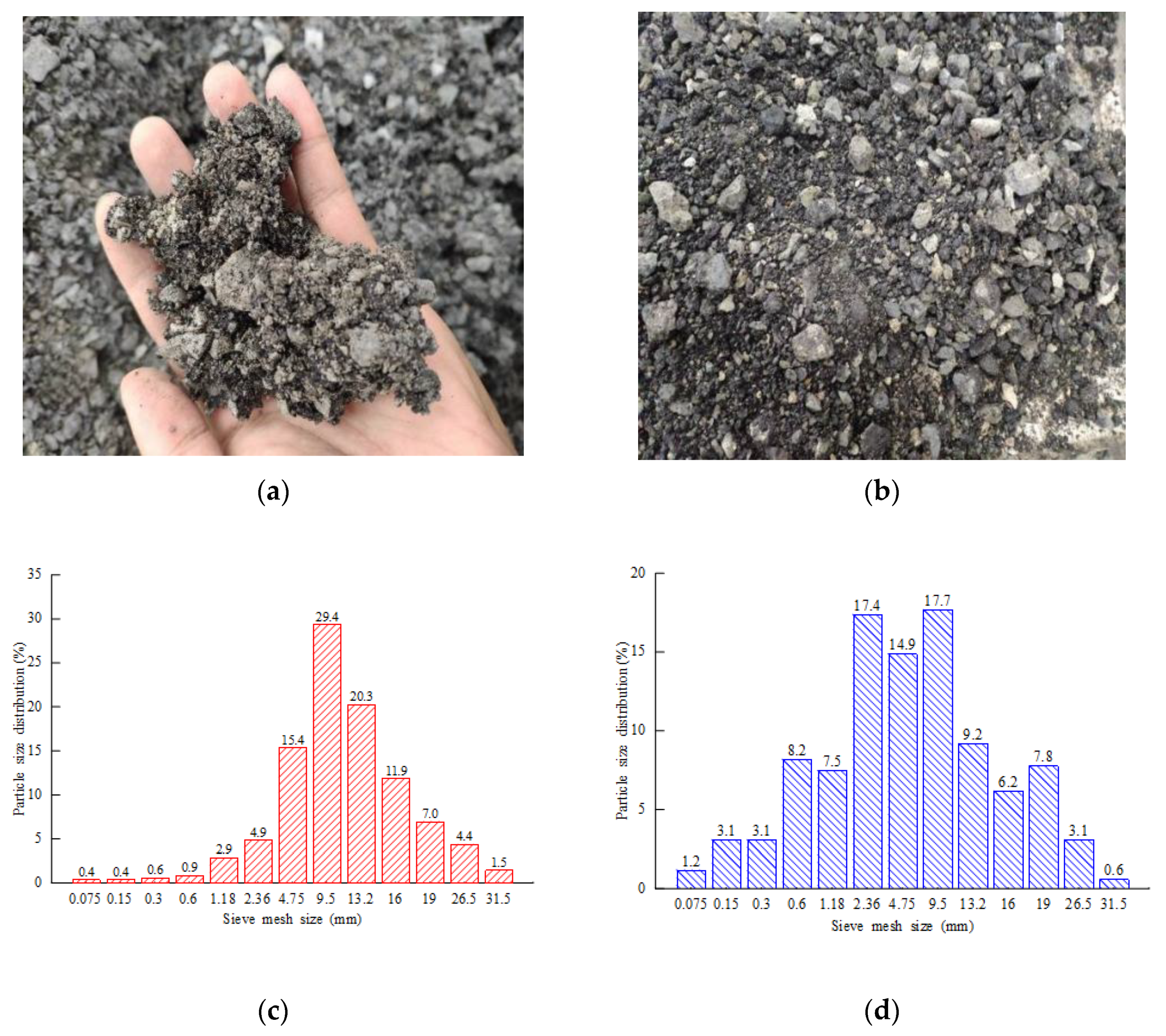
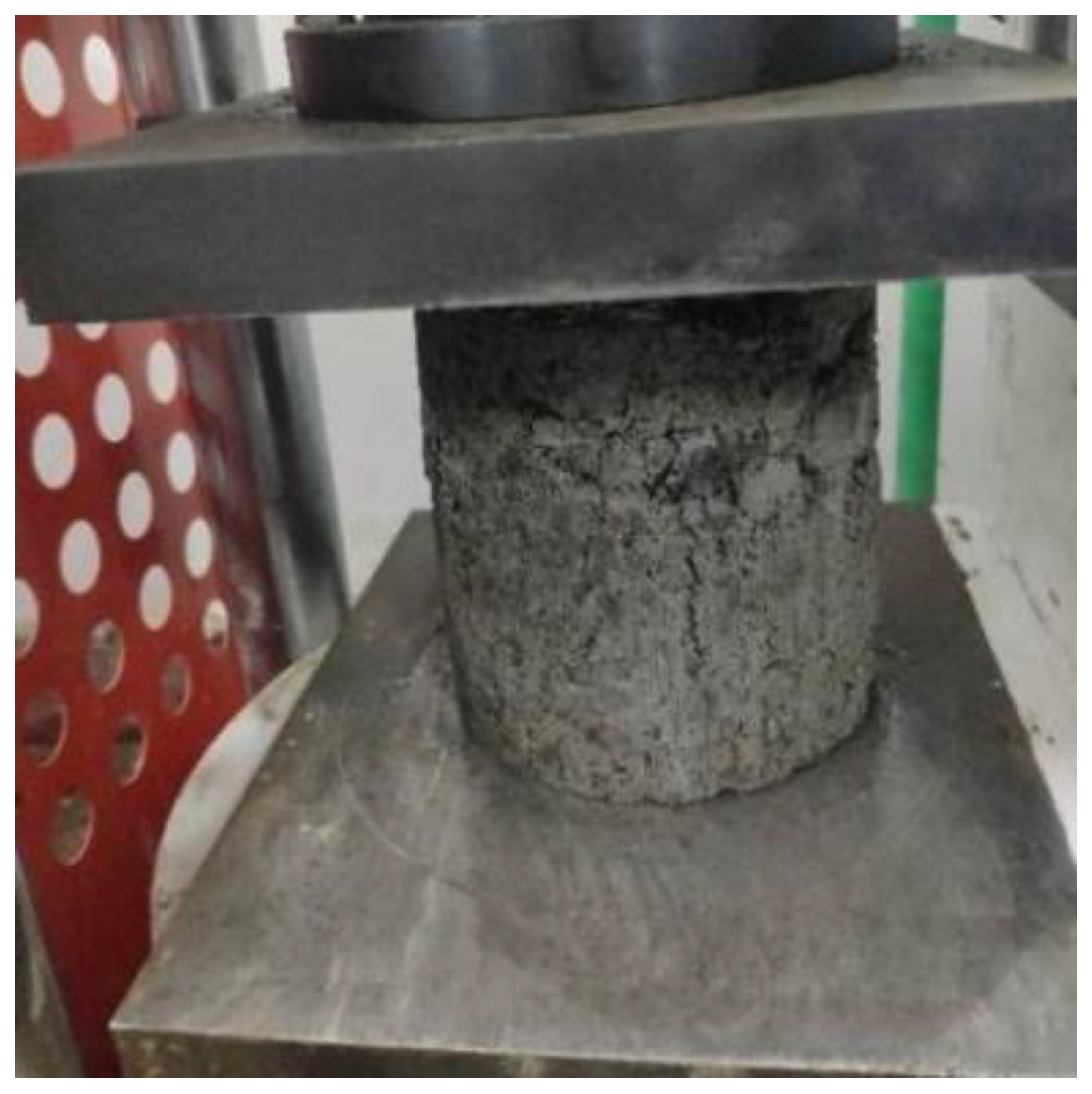
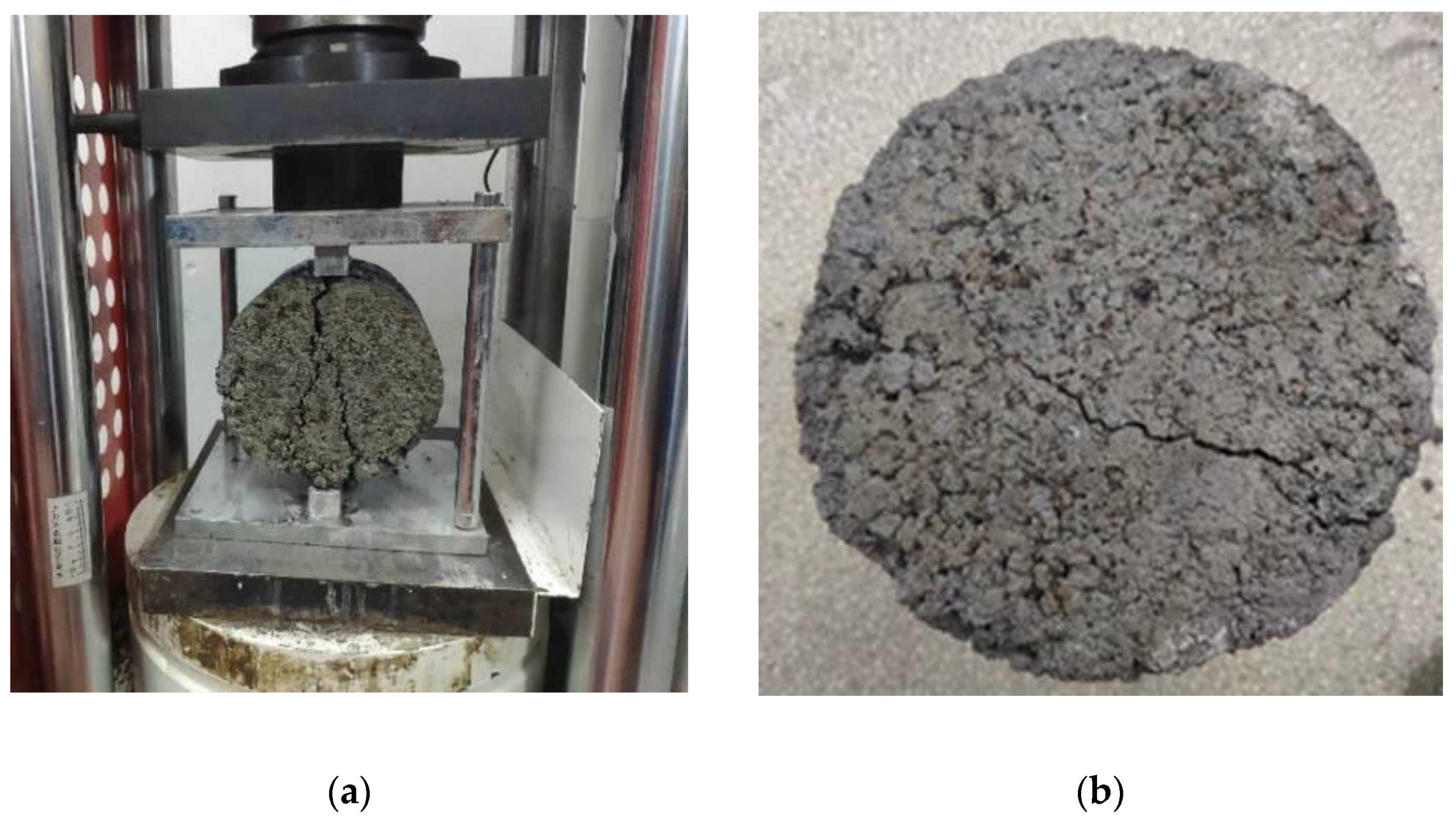

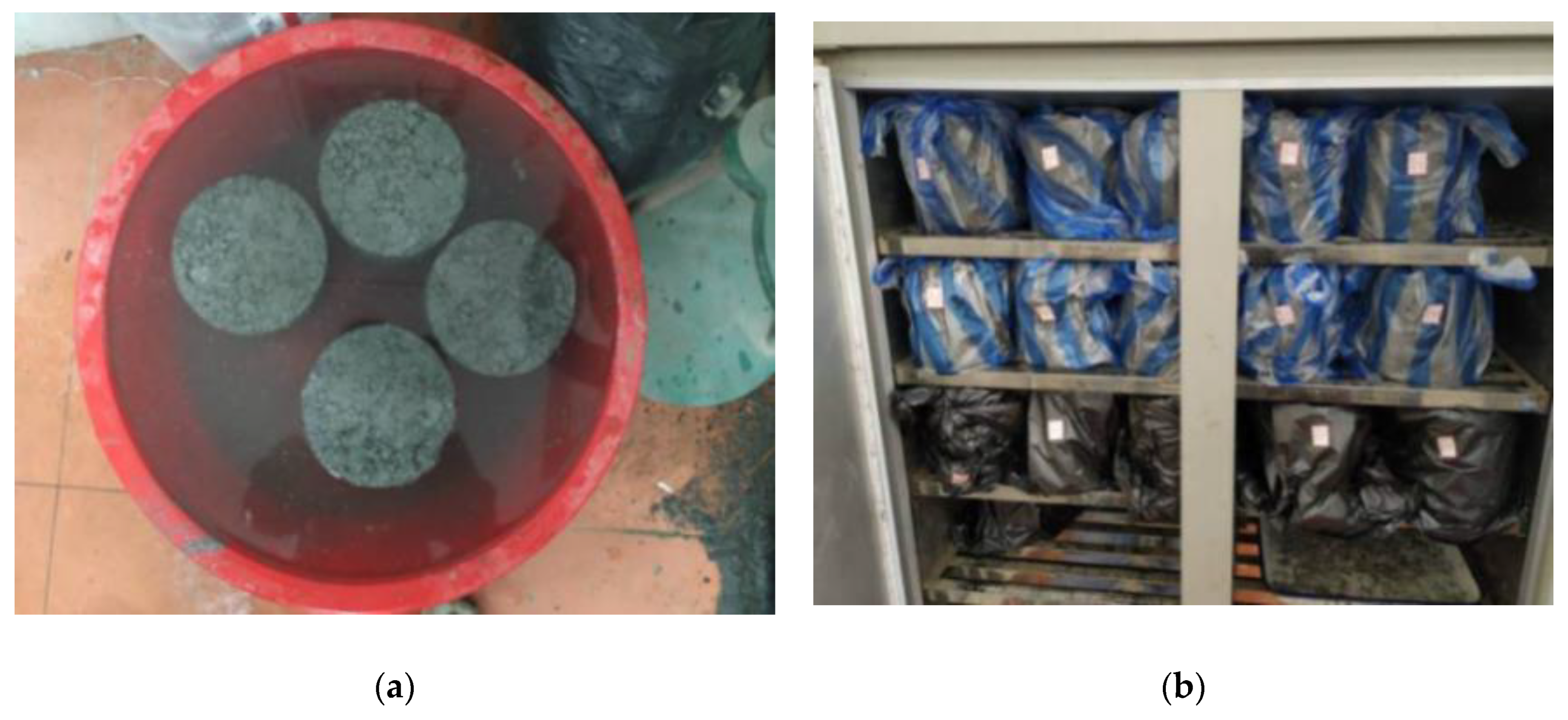
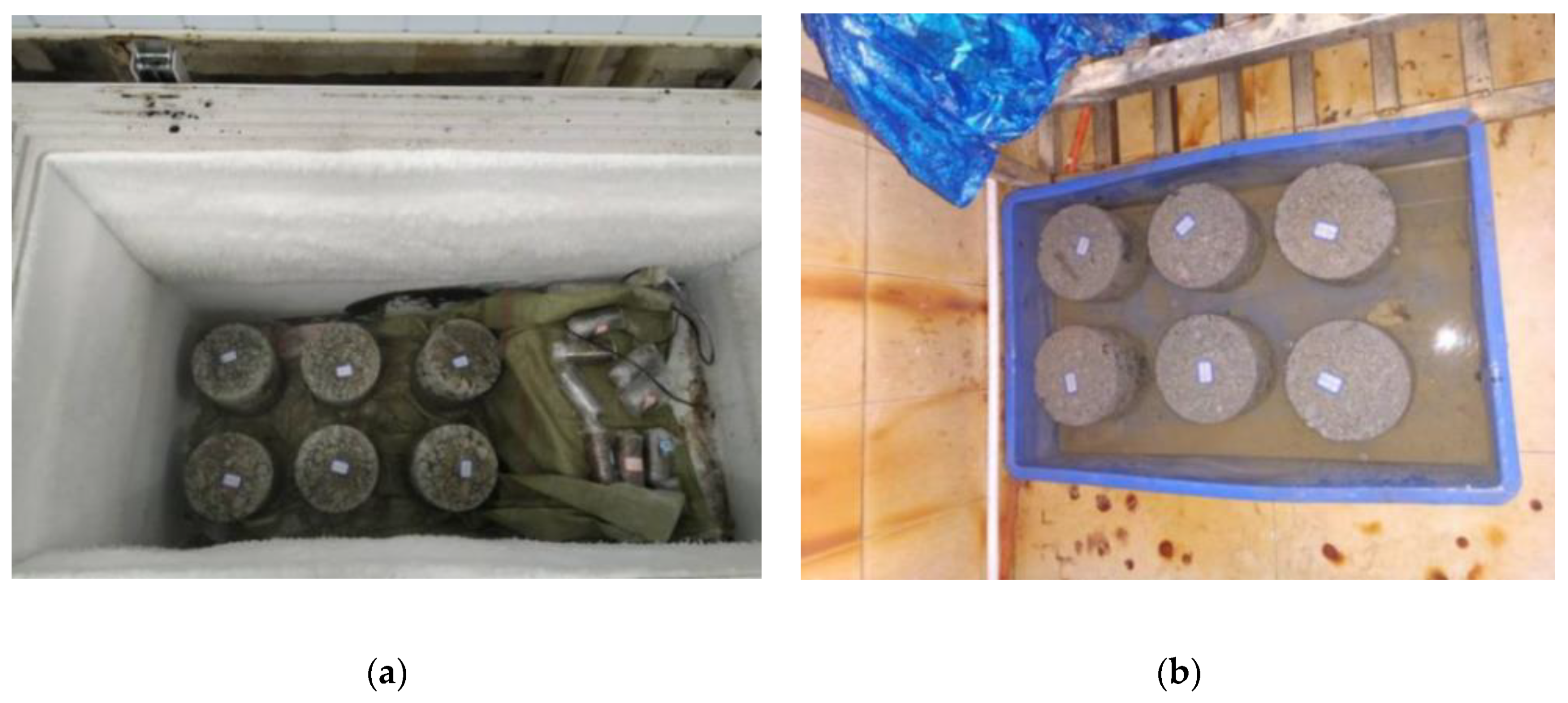
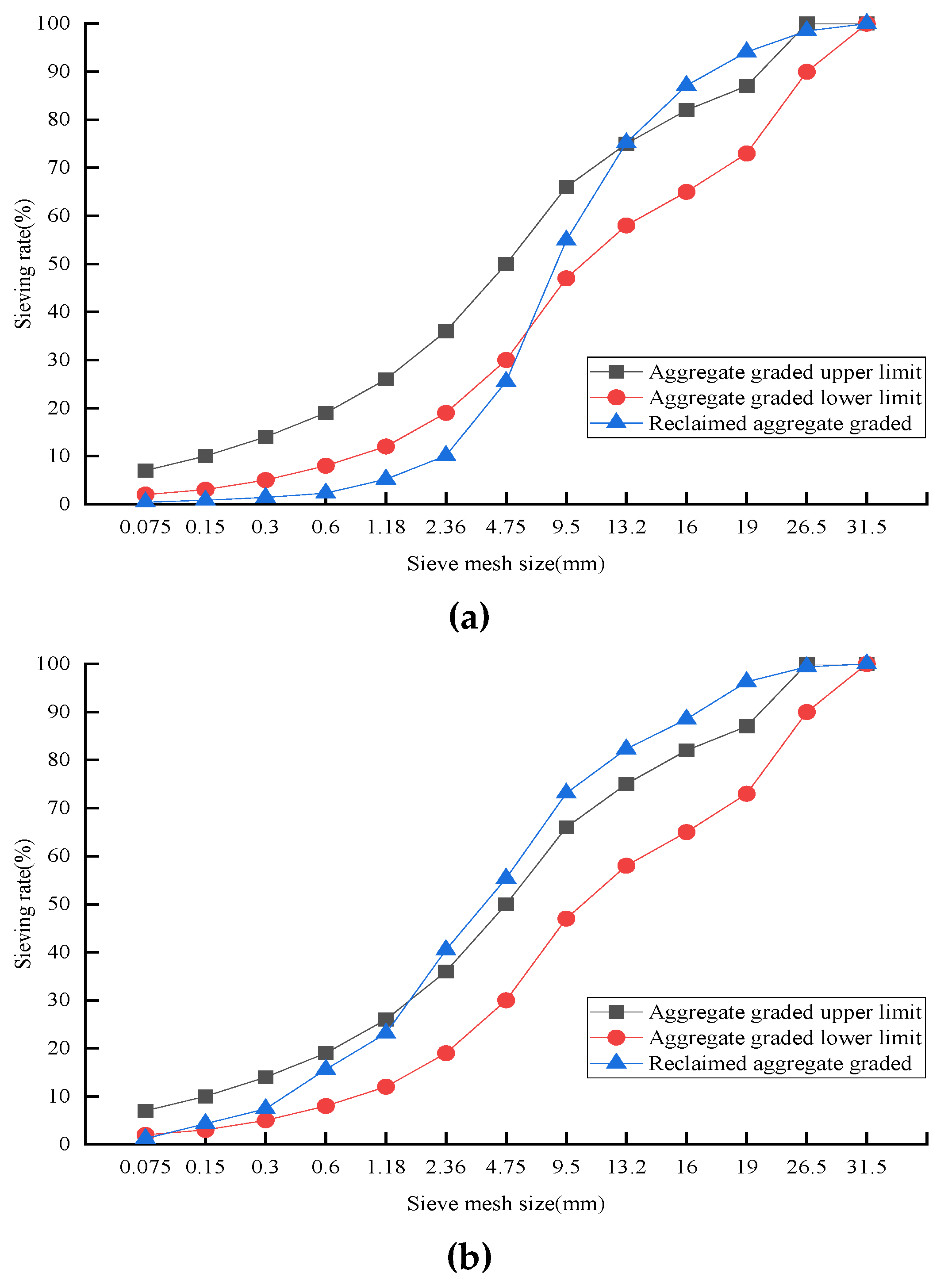

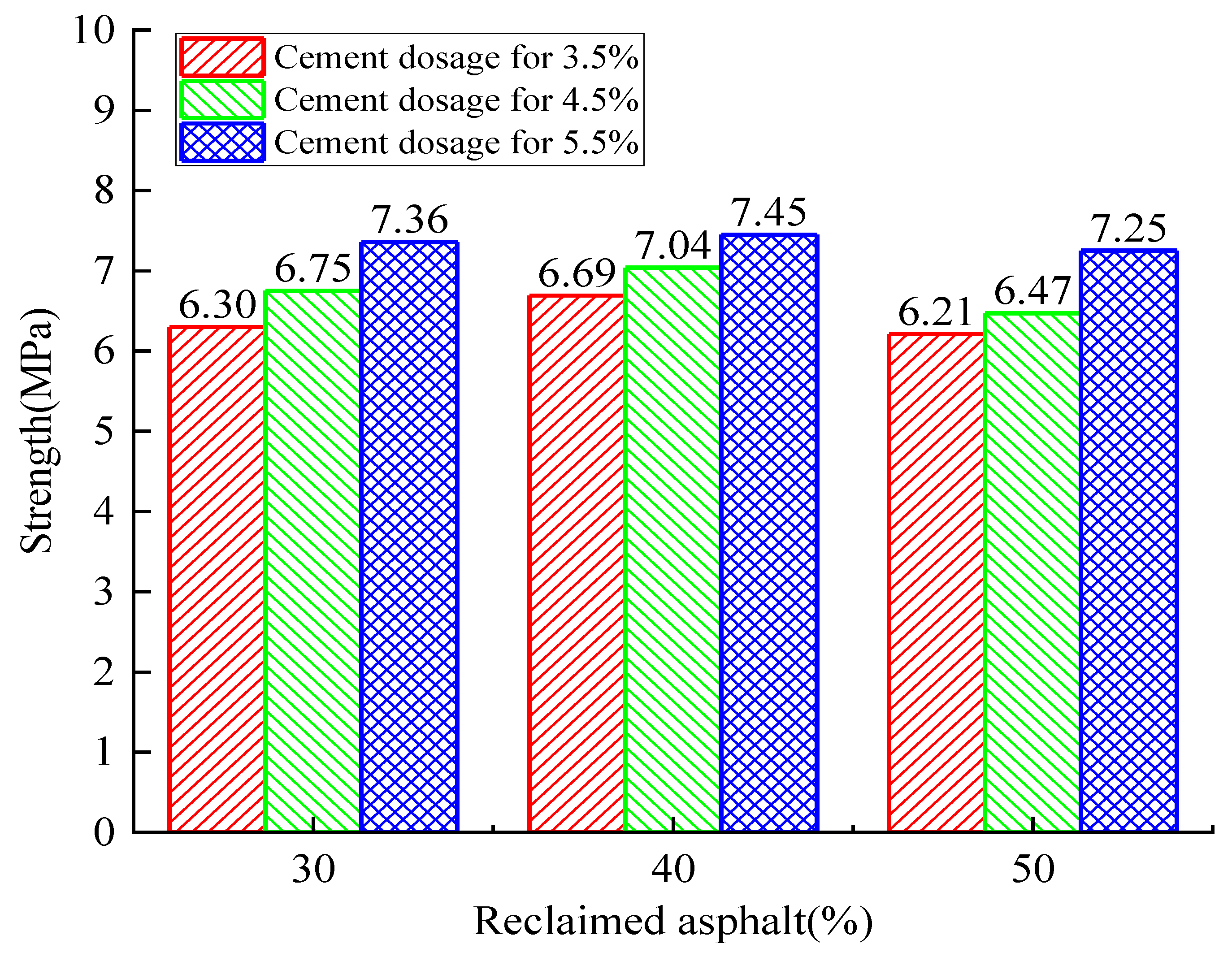
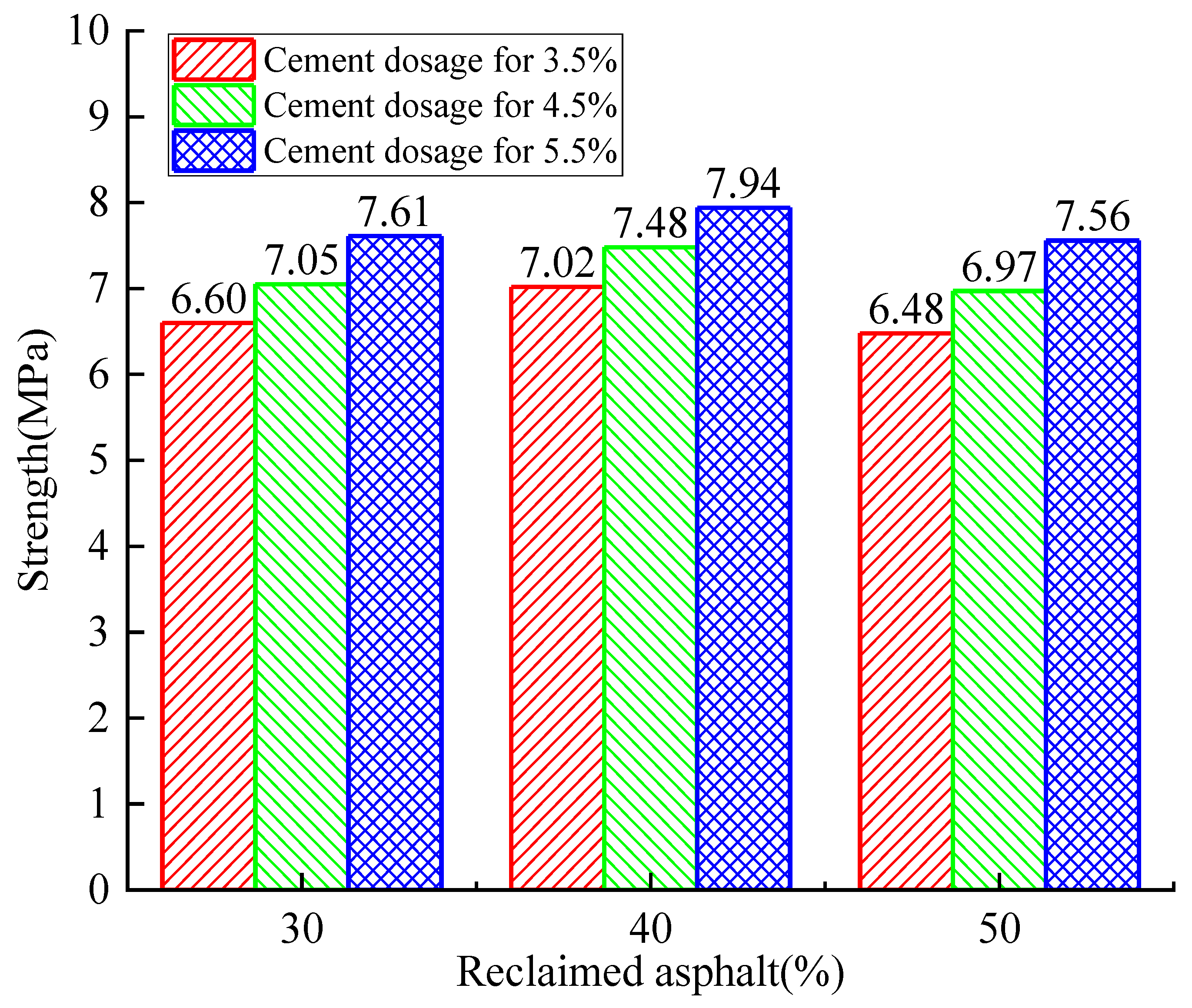

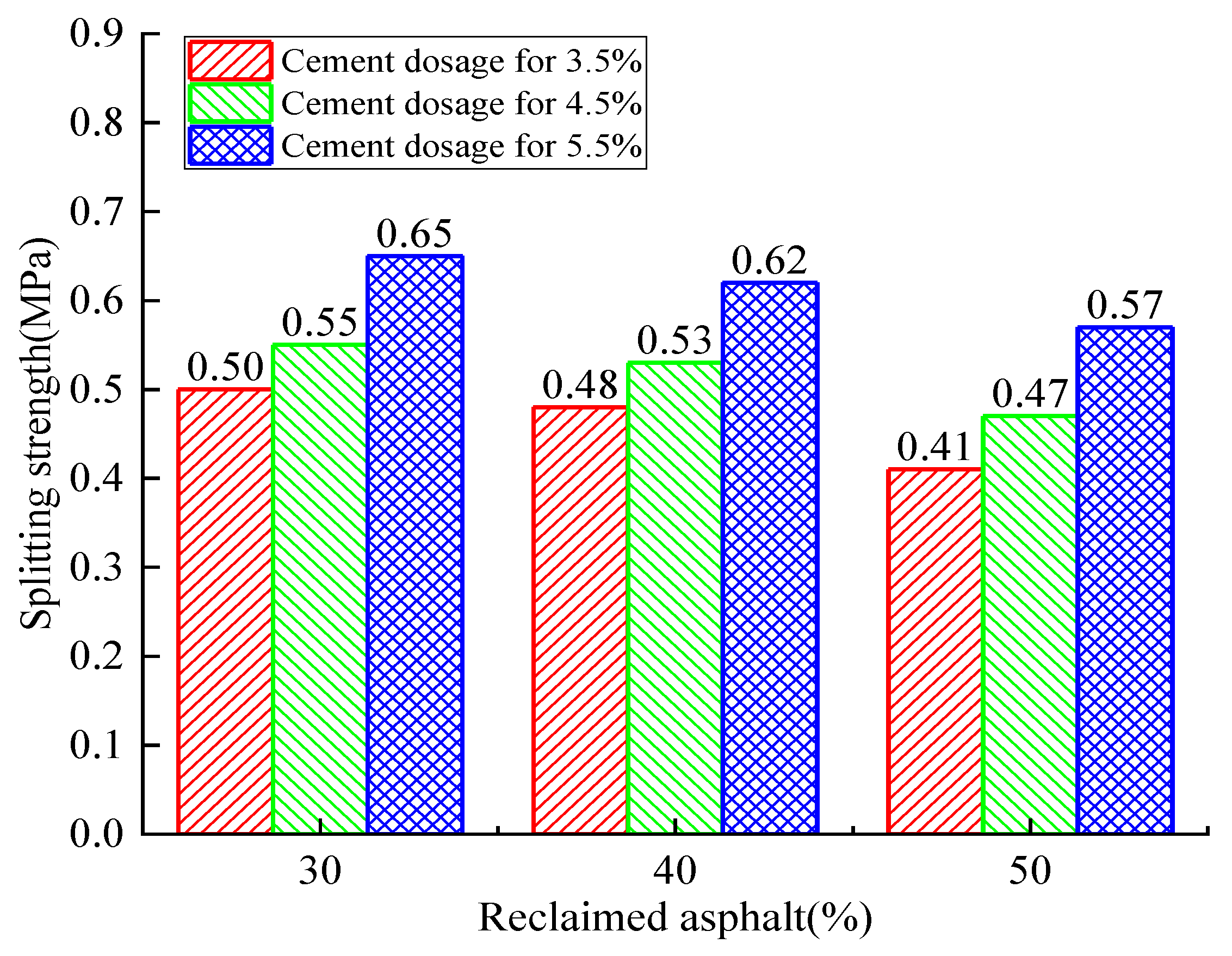
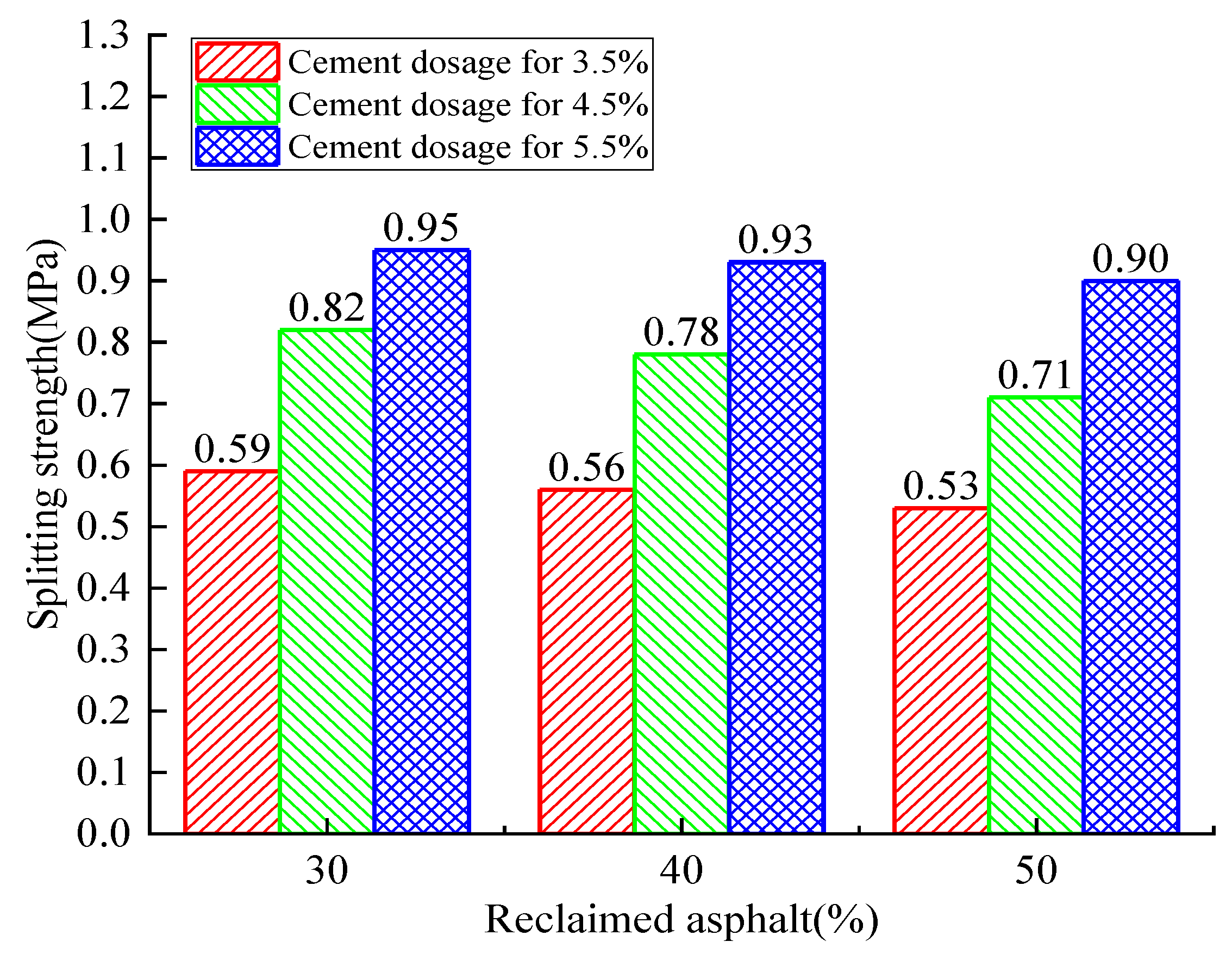
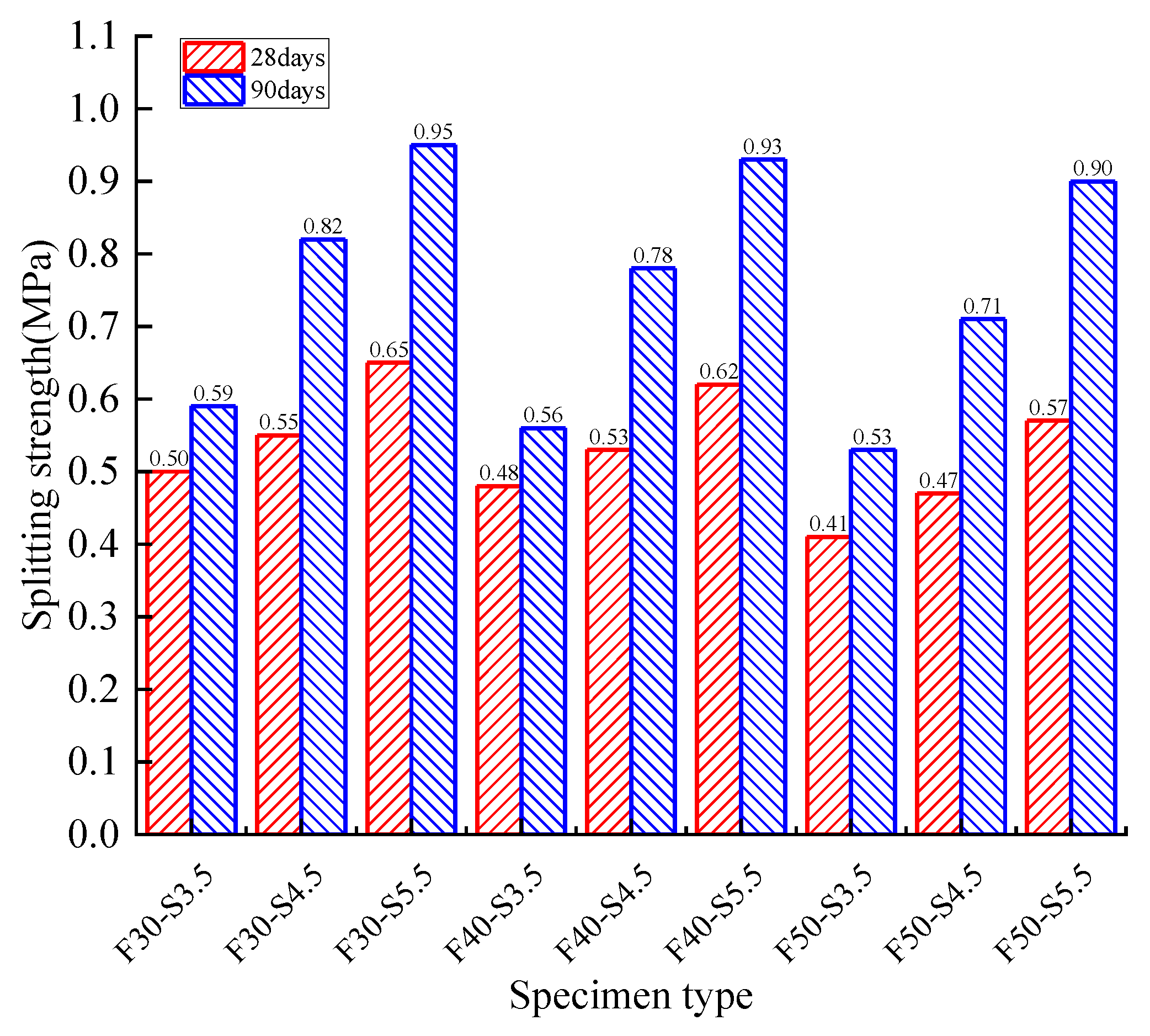


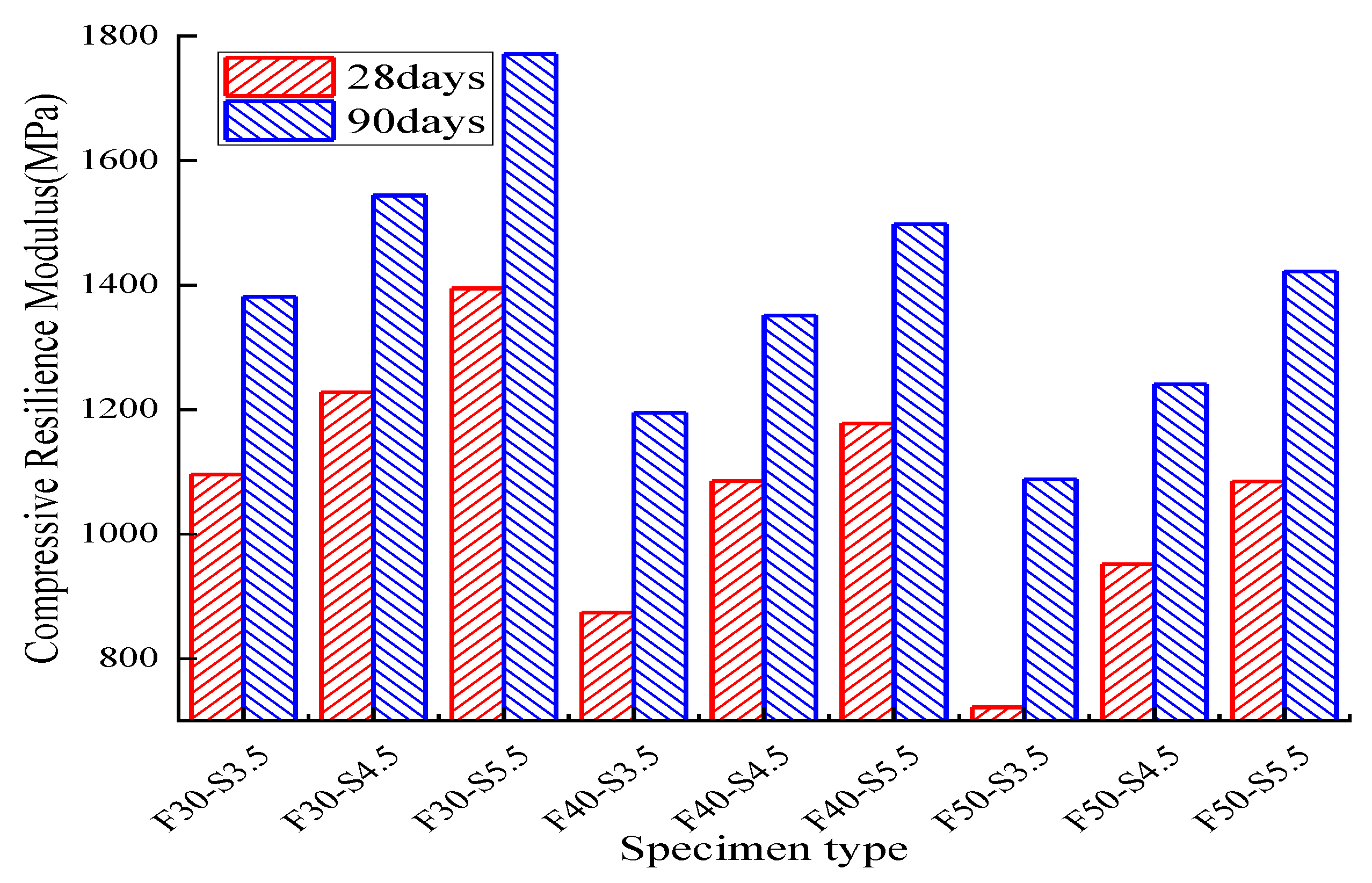
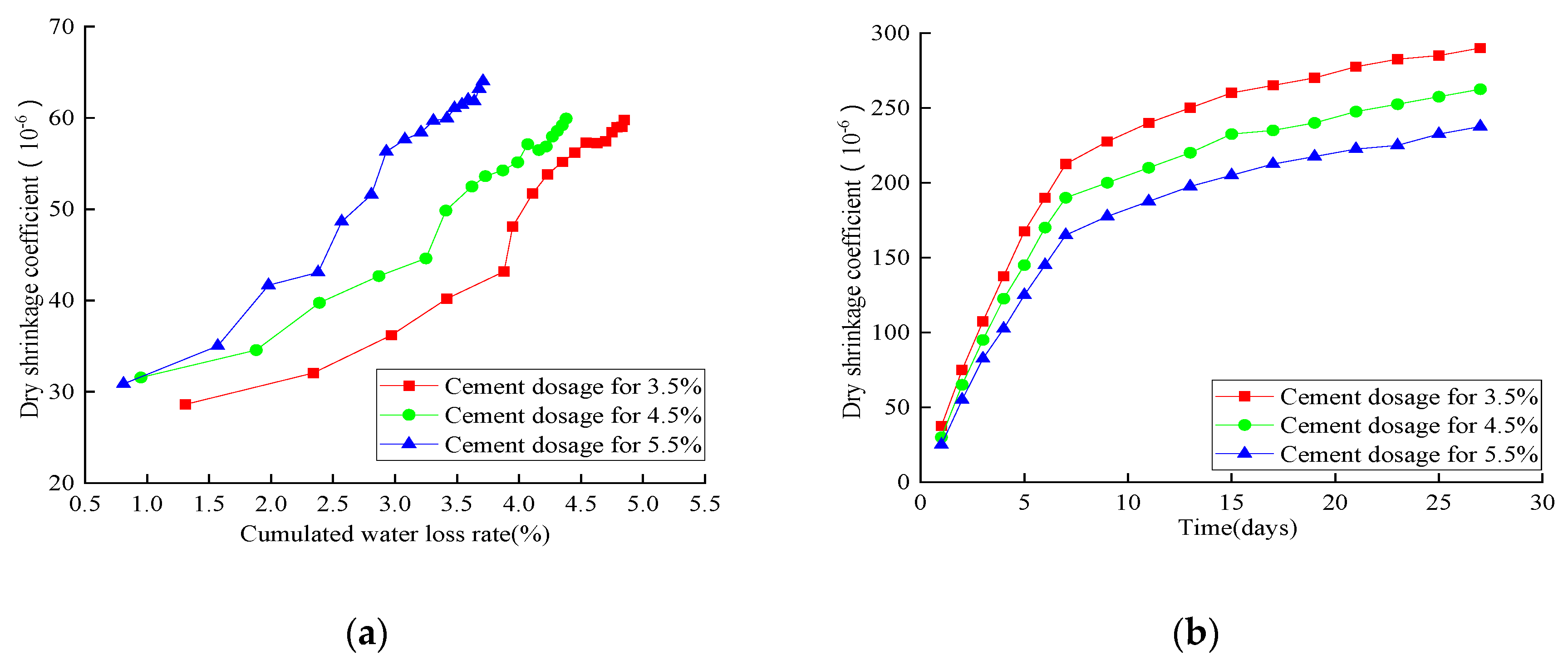
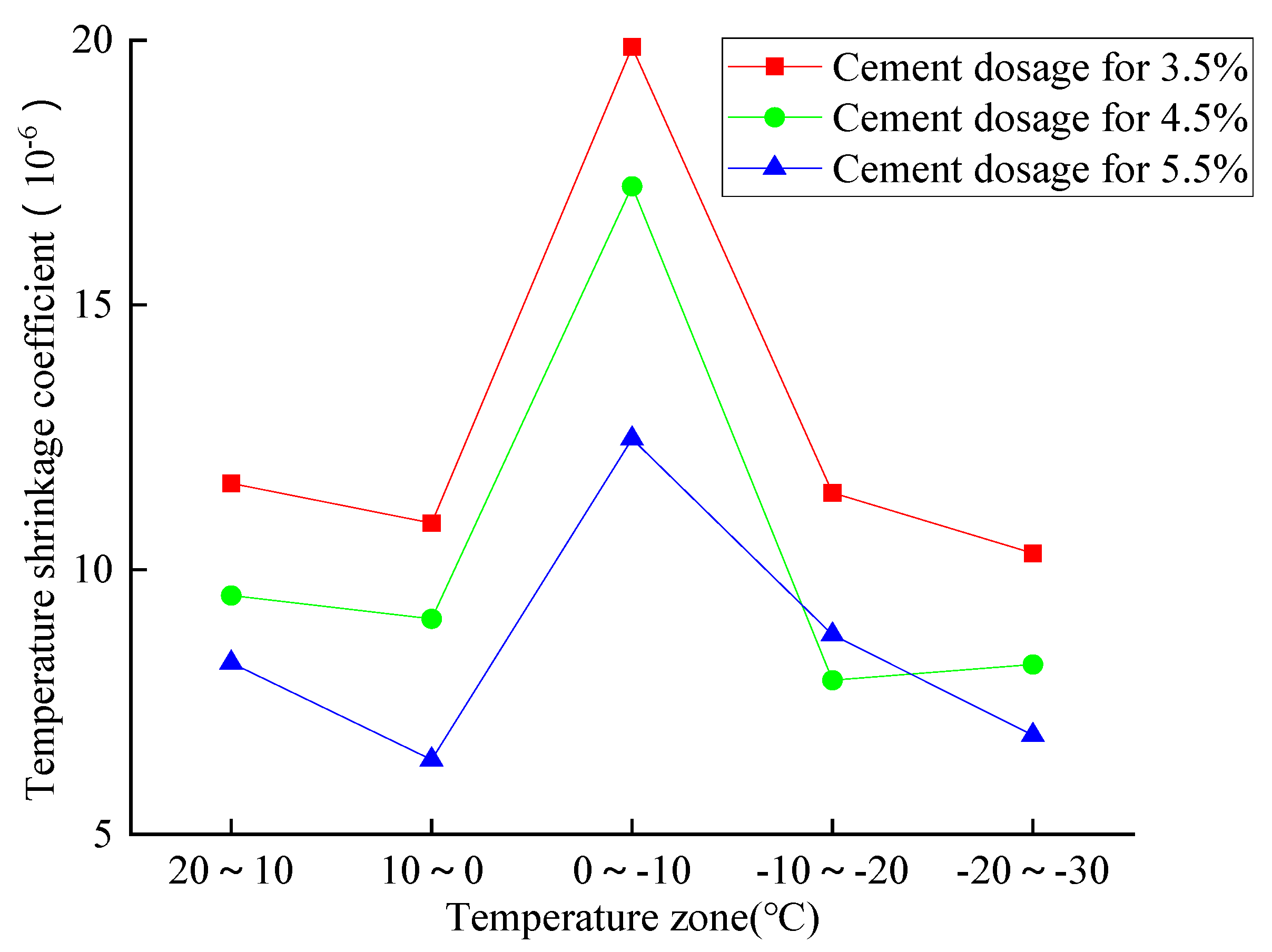
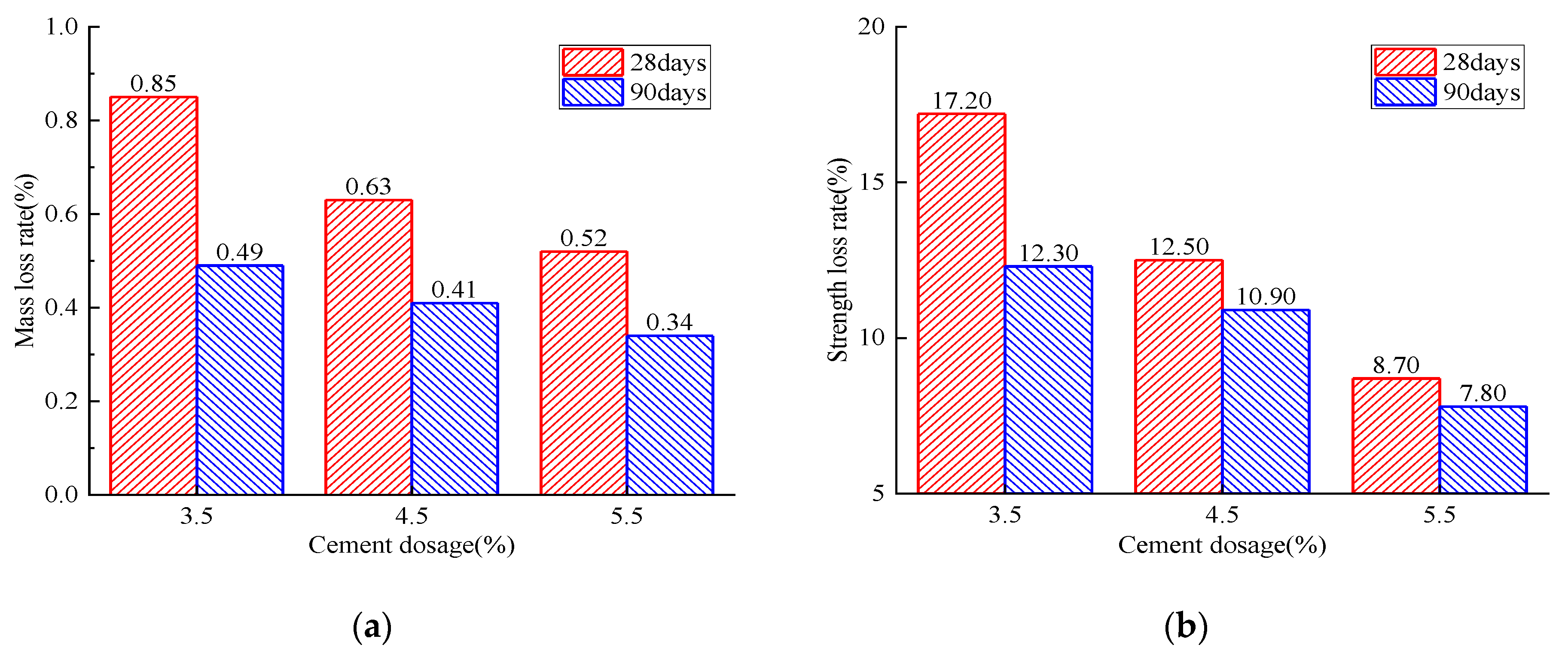

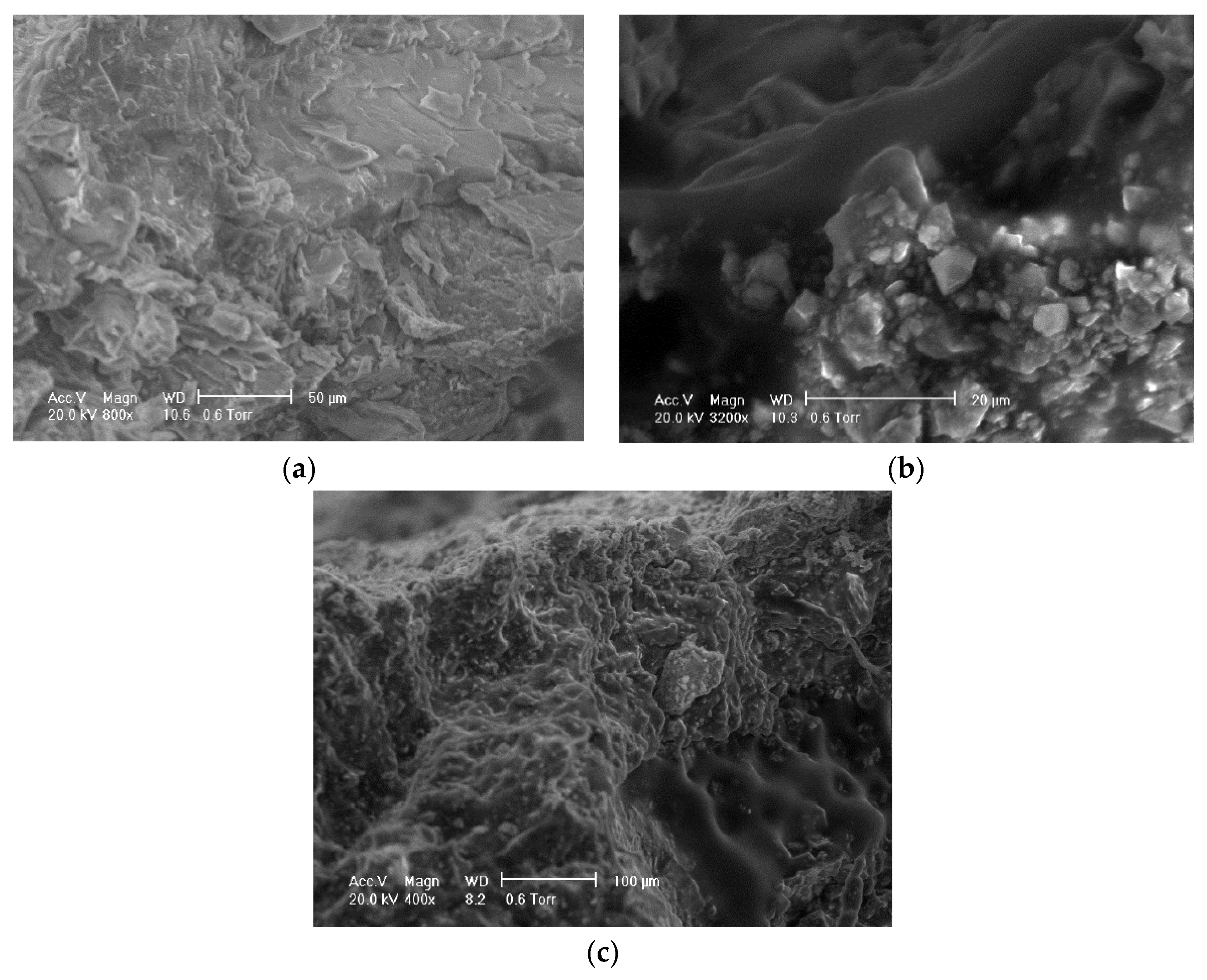
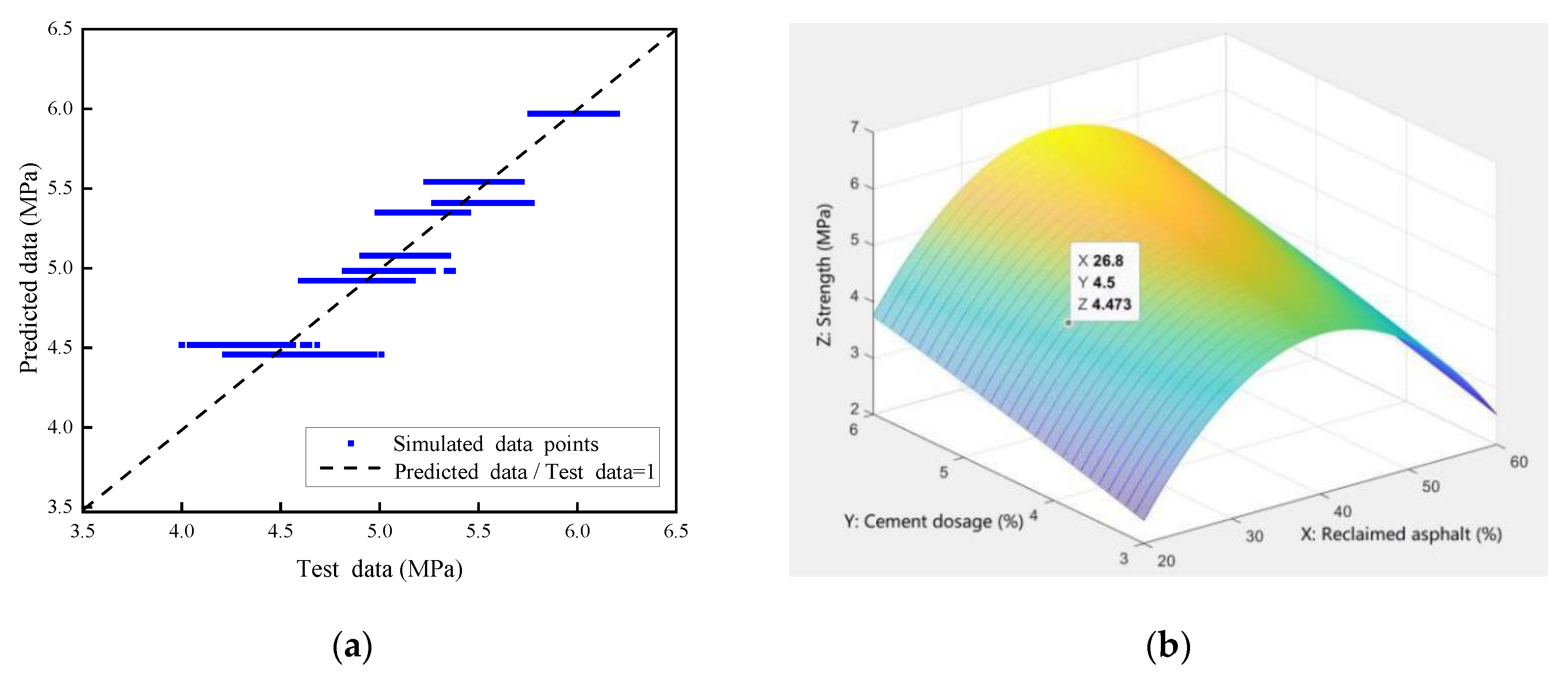
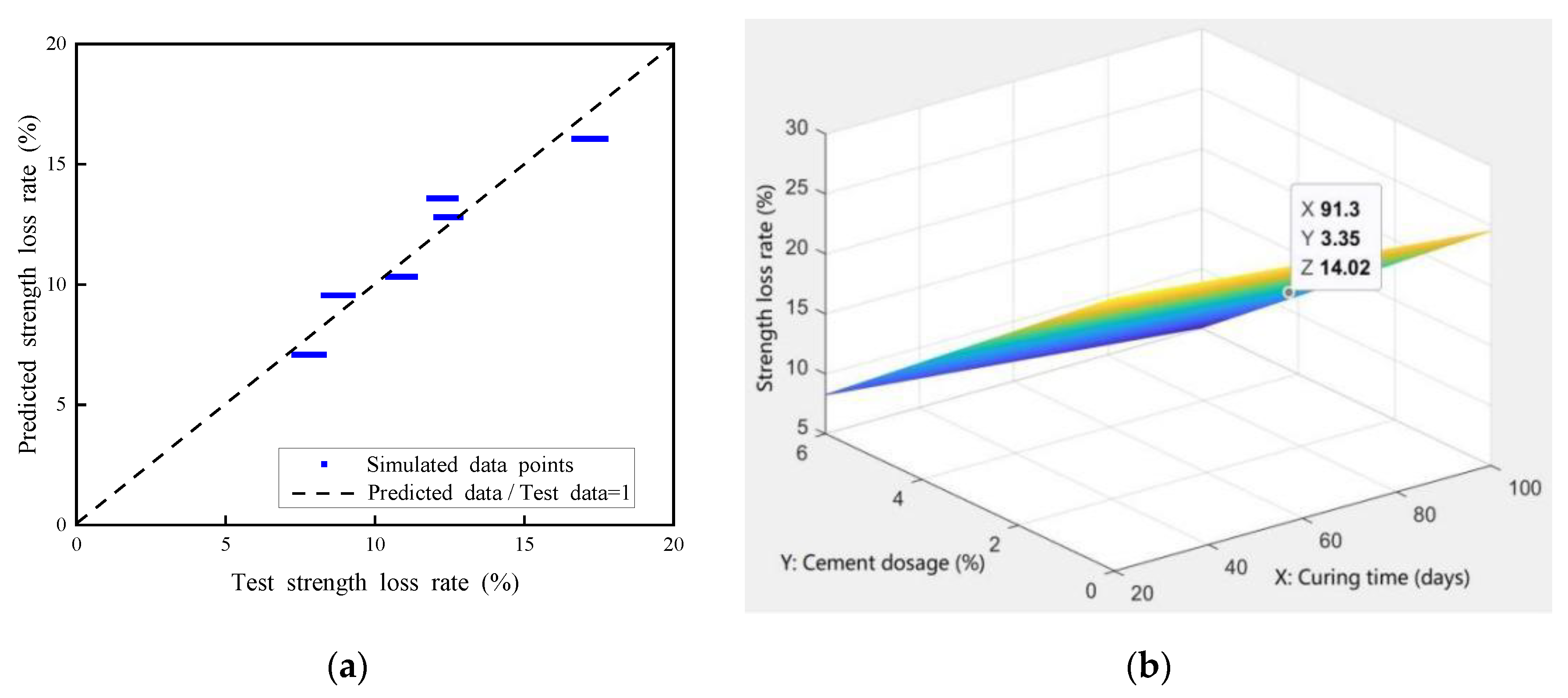
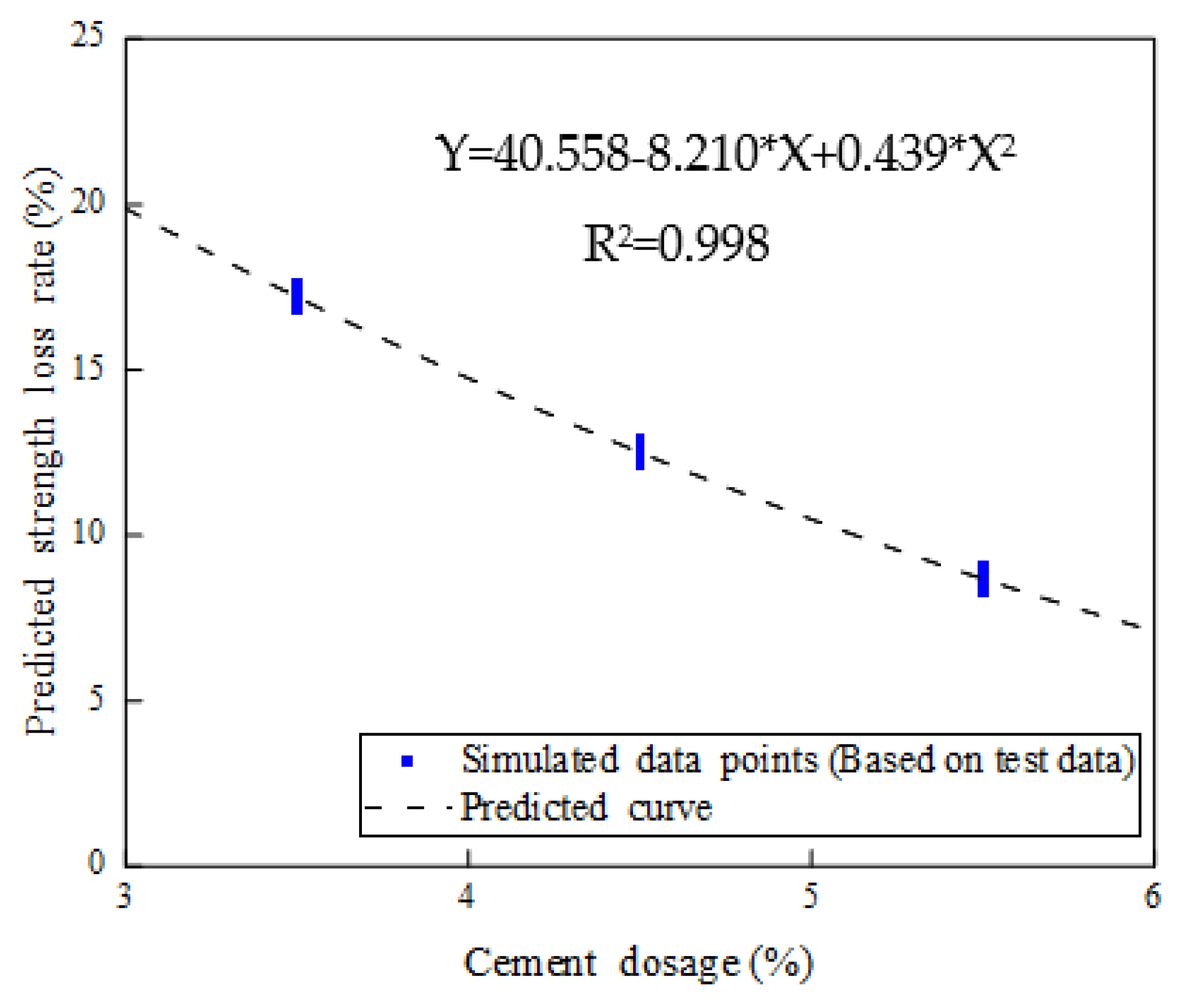
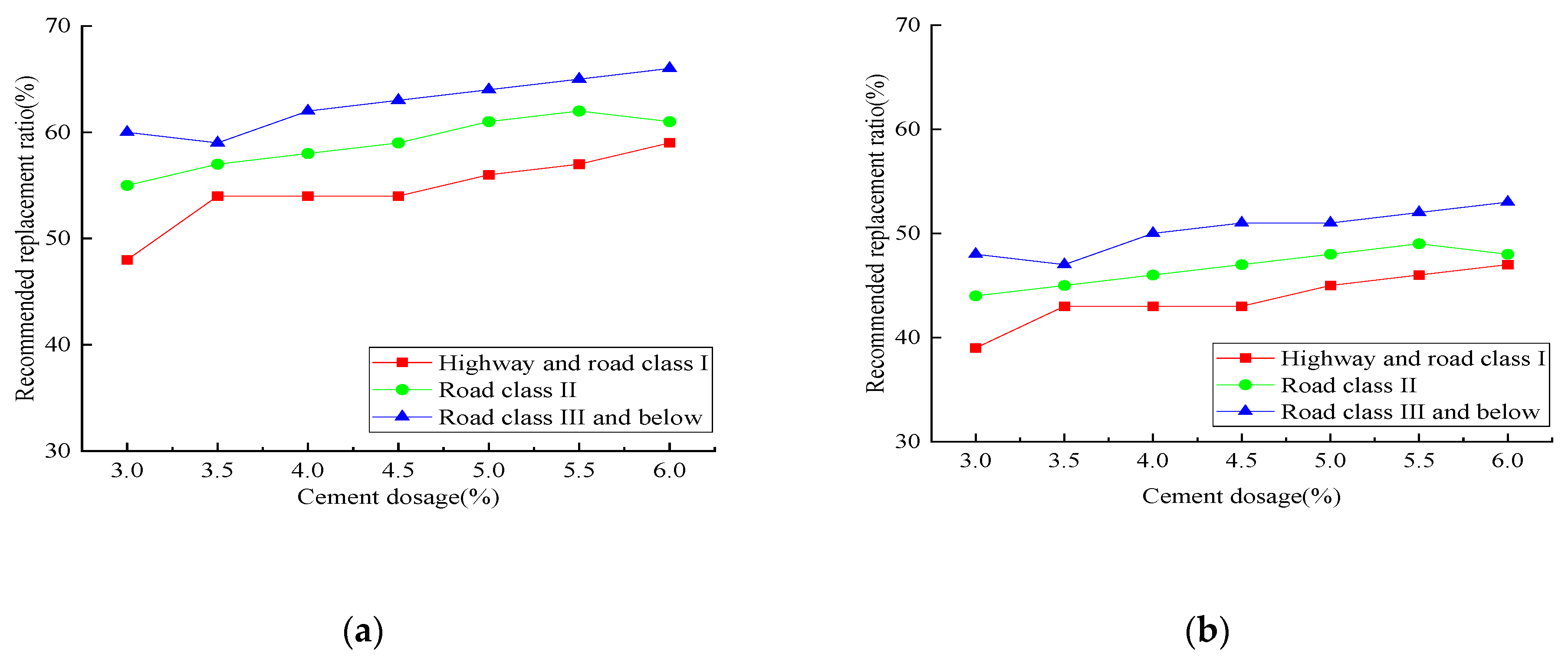
| Aggregate Type | Size (mm) | Apparent Density (g/cm³) | Water Absorption (%) | Void Content (%) |
|---|---|---|---|---|
| RAP | 5–10 | 2.618 | 7.41 | 44.5 |
| 10–20 | 2.666 | 5.31 | 45.3 | |
| NA | 5–10 | 2.721 | 0.91 | 42 |
| 10–20 | 2.719 | 0.45 | 43 |
| No. | Optimum Water Content (%) | Maximum Dry Density (g/cm3) |
|---|---|---|
| F30-S3.5 | 5.24 | 2.25 |
| F40-S3.5 | 4.93 | 2.29 |
| F50-S3.5 | 4.90 | 2.21 |
| F30-S4.5 | 5.25 | 2.29 |
| F40-S4.5 | 5.05 | 2.31 |
| F50-S4.5 | 5.04 | 2.22 |
| F30-S5.5 | 5.30 | 2.31 |
| F40-S5.5 | 5.22 | 2.33 |
| F50-S5.5 | 5.21 | 2.25 |
Publisher’s Note: MDPI stays neutral with regard to jurisdictional claims in published maps and institutional affiliations. |
© 2021 by the authors. Licensee MDPI, Basel, Switzerland. This article is an open access article distributed under the terms and conditions of the Creative Commons Attribution (CC BY) license (https://creativecommons.org/licenses/by/4.0/).
Share and Cite
Xu, W.; Li, W.; Ji, Y. Mechanical Behavior Investigation of Reclaimed Asphalt Aggregate Concrete in a Cold Region. Materials 2021, 14, 4101. https://doi.org/10.3390/ma14154101
Xu W, Li W, Ji Y. Mechanical Behavior Investigation of Reclaimed Asphalt Aggregate Concrete in a Cold Region. Materials. 2021; 14(15):4101. https://doi.org/10.3390/ma14154101
Chicago/Turabian StyleXu, Wenyuan, Wei Li, and Yongcheng Ji. 2021. "Mechanical Behavior Investigation of Reclaimed Asphalt Aggregate Concrete in a Cold Region" Materials 14, no. 15: 4101. https://doi.org/10.3390/ma14154101
APA StyleXu, W., Li, W., & Ji, Y. (2021). Mechanical Behavior Investigation of Reclaimed Asphalt Aggregate Concrete in a Cold Region. Materials, 14(15), 4101. https://doi.org/10.3390/ma14154101





